Social Changes & Globalisation Influence on 21st Century Education
VerifiedAdded on 2023/05/30
|6
|1489
|121
Essay
AI Summary
This essay provides an overview of the changes in teaching and learning in the 21st century, emphasizing the shift from traditional, teacher-centered approaches to student-centered, collaborative learning environments. It highlights the key competencies of digital literacy, problem-solving, and critical thinking, driven by technological advancements and globalization. The essay discusses how education is adapting to prepare students for a technology-rich, fast-paced workplace, and examines the impact of social changes and globalization on educational institutions, including the widening gap between rich and poor students. It concludes that learning and teaching have transitioned from a passive state to an active one, with students becoming both recipients and creators of knowledge, and teachers acting as facilitators of learning.
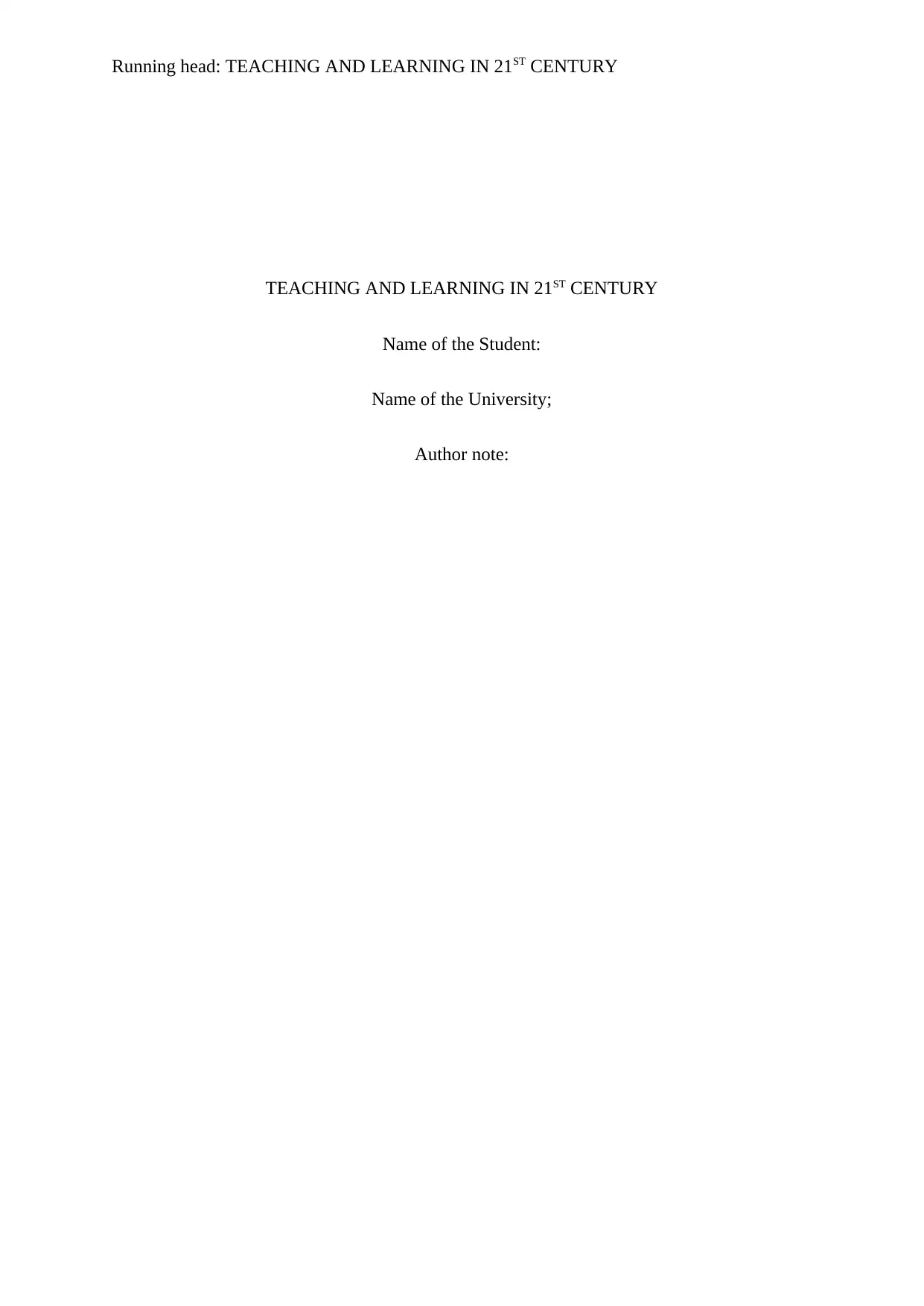
Running head: TEACHING AND LEARNING IN 21ST CENTURY
TEACHING AND LEARNING IN 21ST CENTURY
Name of the Student:
Name of the University;
Author note:
TEACHING AND LEARNING IN 21ST CENTURY
Name of the Student:
Name of the University;
Author note:
Paraphrase This Document
Need a fresh take? Get an instant paraphrase of this document with our AI Paraphraser

1TEACHING AND LEARNING IN 21ST CENTURY
In this 21st century, the world is rapidly changing and is becoming progressively
complex due to the constant increase in the flow of information which is becoming more and
more accessible with each passing day (Crystal, 2013). This paper will provide a clear
understanding of the continuous changes that is taking place in this 21st century in the field of
teaching and learning. It shall briefly elaborate on demonstrating the trends of 21st century
teaching and learning process and shall also provide the key factors that are changing the
education in the present era. With the same, the paper shall also shed light on how different
social changes and globalisation are influencing education.
The term “21st century” is basically concerned with certain key competencies like
digital literacy, collaboration, problem solving and critical thinking. It advocates and believe
that schools need to teach in order to help the learners thrive in this world of 21st century.
This world is extremely different than it was a few years back. The people in this world, the
various cultures, the economies, all have become totally connected and is driven by the low-
cost telecommunication technology, new and unique innovations and most importantly, the
internet. Computer is the most important element in this modern era to become a successful
student as all the necessary information is accessible online (Daniel, 2015). Multi-tasking has
become a common trend. The fact that multitasking cannot be done by some people, does not
mean that it cannot be done by anyone. Today, students are learning differently than before.
The teachers are teaching differently than before. Education has changed now. This 21st
century allow the students to become both the recipients and the creators of knowledge and
information. This makes them prepared for a new type of workplace of the future- the
technology-rich and fast paced workplace.
It is eighteen years into this new millennium and the educators are continuously
debating on what is making a teacher or an educator effective in this 21st century. There are
some who would say that the former or the traditional methods of teaching have stood the test
In this 21st century, the world is rapidly changing and is becoming progressively
complex due to the constant increase in the flow of information which is becoming more and
more accessible with each passing day (Crystal, 2013). This paper will provide a clear
understanding of the continuous changes that is taking place in this 21st century in the field of
teaching and learning. It shall briefly elaborate on demonstrating the trends of 21st century
teaching and learning process and shall also provide the key factors that are changing the
education in the present era. With the same, the paper shall also shed light on how different
social changes and globalisation are influencing education.
The term “21st century” is basically concerned with certain key competencies like
digital literacy, collaboration, problem solving and critical thinking. It advocates and believe
that schools need to teach in order to help the learners thrive in this world of 21st century.
This world is extremely different than it was a few years back. The people in this world, the
various cultures, the economies, all have become totally connected and is driven by the low-
cost telecommunication technology, new and unique innovations and most importantly, the
internet. Computer is the most important element in this modern era to become a successful
student as all the necessary information is accessible online (Daniel, 2015). Multi-tasking has
become a common trend. The fact that multitasking cannot be done by some people, does not
mean that it cannot be done by anyone. Today, students are learning differently than before.
The teachers are teaching differently than before. Education has changed now. This 21st
century allow the students to become both the recipients and the creators of knowledge and
information. This makes them prepared for a new type of workplace of the future- the
technology-rich and fast paced workplace.
It is eighteen years into this new millennium and the educators are continuously
debating on what is making a teacher or an educator effective in this 21st century. There are
some who would say that the former or the traditional methods of teaching have stood the test
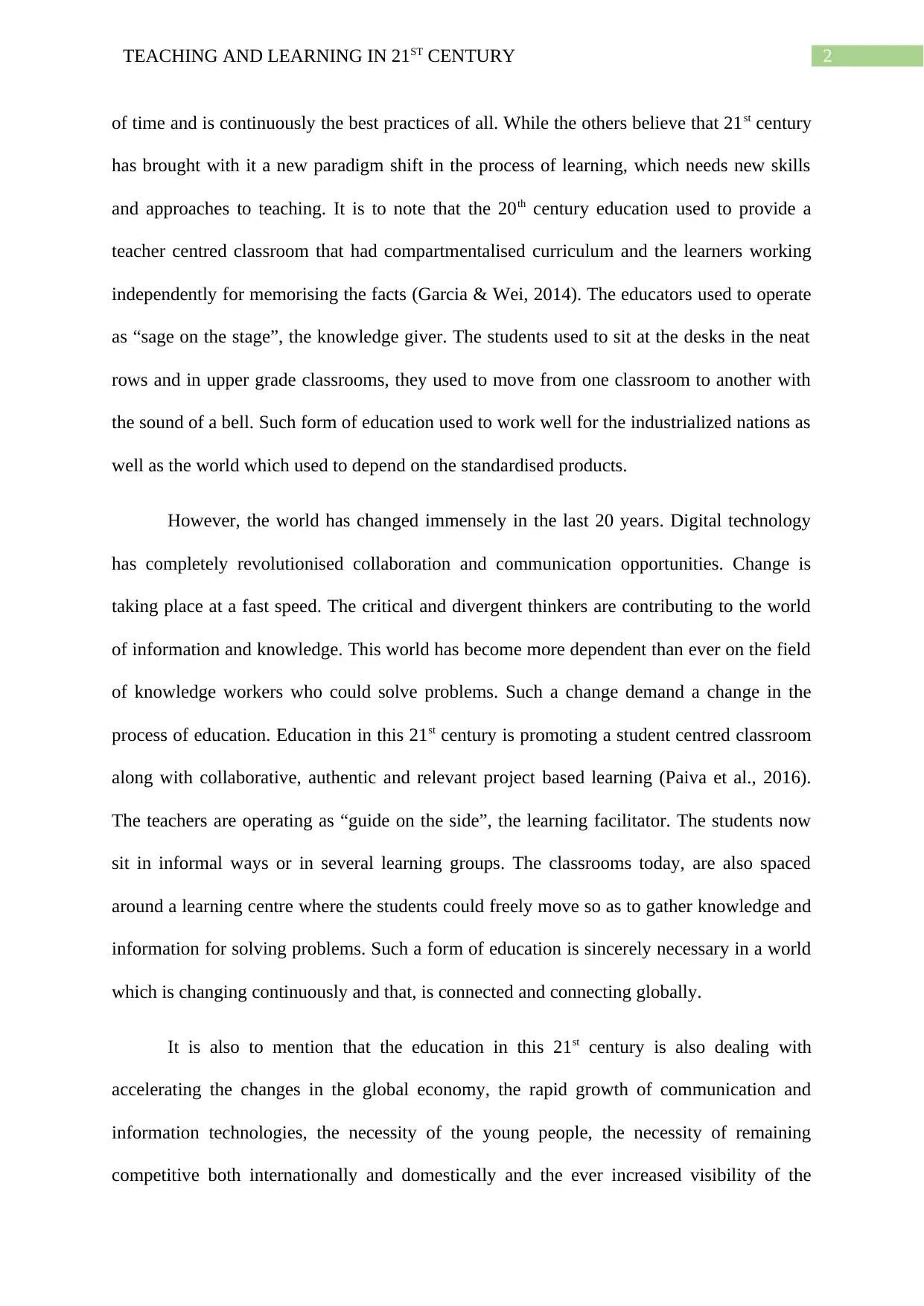
2TEACHING AND LEARNING IN 21ST CENTURY
of time and is continuously the best practices of all. While the others believe that 21st century
has brought with it a new paradigm shift in the process of learning, which needs new skills
and approaches to teaching. It is to note that the 20th century education used to provide a
teacher centred classroom that had compartmentalised curriculum and the learners working
independently for memorising the facts (Garcia & Wei, 2014). The educators used to operate
as “sage on the stage”, the knowledge giver. The students used to sit at the desks in the neat
rows and in upper grade classrooms, they used to move from one classroom to another with
the sound of a bell. Such form of education used to work well for the industrialized nations as
well as the world which used to depend on the standardised products.
However, the world has changed immensely in the last 20 years. Digital technology
has completely revolutionised collaboration and communication opportunities. Change is
taking place at a fast speed. The critical and divergent thinkers are contributing to the world
of information and knowledge. This world has become more dependent than ever on the field
of knowledge workers who could solve problems. Such a change demand a change in the
process of education. Education in this 21st century is promoting a student centred classroom
along with collaborative, authentic and relevant project based learning (Paiva et al., 2016).
The teachers are operating as “guide on the side”, the learning facilitator. The students now
sit in informal ways or in several learning groups. The classrooms today, are also spaced
around a learning centre where the students could freely move so as to gather knowledge and
information for solving problems. Such a form of education is sincerely necessary in a world
which is changing continuously and that, is connected and connecting globally.
It is also to mention that the education in this 21st century is also dealing with
accelerating the changes in the global economy, the rapid growth of communication and
information technologies, the necessity of the young people, the necessity of remaining
competitive both internationally and domestically and the ever increased visibility of the
of time and is continuously the best practices of all. While the others believe that 21st century
has brought with it a new paradigm shift in the process of learning, which needs new skills
and approaches to teaching. It is to note that the 20th century education used to provide a
teacher centred classroom that had compartmentalised curriculum and the learners working
independently for memorising the facts (Garcia & Wei, 2014). The educators used to operate
as “sage on the stage”, the knowledge giver. The students used to sit at the desks in the neat
rows and in upper grade classrooms, they used to move from one classroom to another with
the sound of a bell. Such form of education used to work well for the industrialized nations as
well as the world which used to depend on the standardised products.
However, the world has changed immensely in the last 20 years. Digital technology
has completely revolutionised collaboration and communication opportunities. Change is
taking place at a fast speed. The critical and divergent thinkers are contributing to the world
of information and knowledge. This world has become more dependent than ever on the field
of knowledge workers who could solve problems. Such a change demand a change in the
process of education. Education in this 21st century is promoting a student centred classroom
along with collaborative, authentic and relevant project based learning (Paiva et al., 2016).
The teachers are operating as “guide on the side”, the learning facilitator. The students now
sit in informal ways or in several learning groups. The classrooms today, are also spaced
around a learning centre where the students could freely move so as to gather knowledge and
information for solving problems. Such a form of education is sincerely necessary in a world
which is changing continuously and that, is connected and connecting globally.
It is also to mention that the education in this 21st century is also dealing with
accelerating the changes in the global economy, the rapid growth of communication and
information technologies, the necessity of the young people, the necessity of remaining
competitive both internationally and domestically and the ever increased visibility of the
⊘ This is a preview!⊘
Do you want full access?
Subscribe today to unlock all pages.

Trusted by 1+ million students worldwide
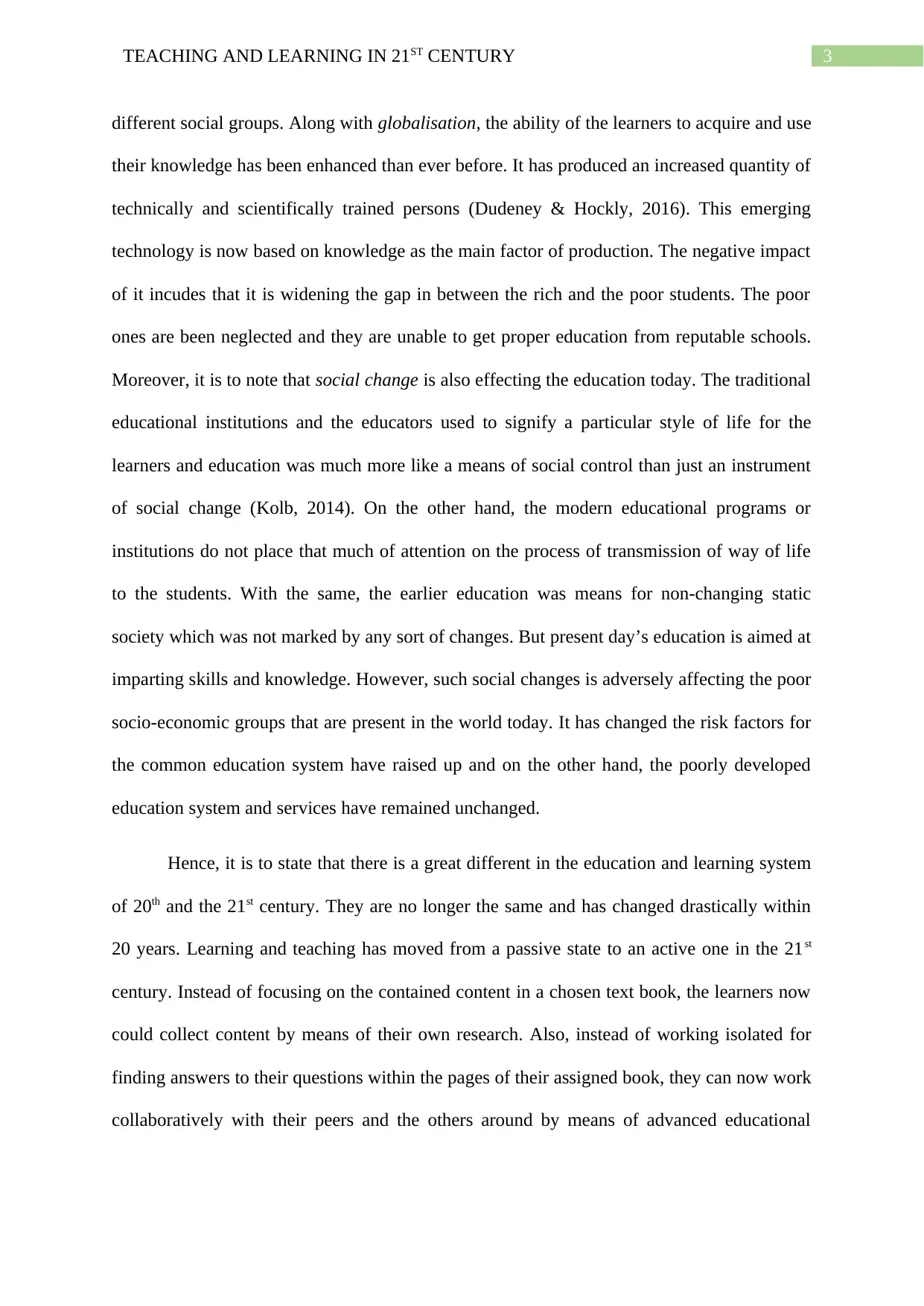
3TEACHING AND LEARNING IN 21ST CENTURY
different social groups. Along with globalisation, the ability of the learners to acquire and use
their knowledge has been enhanced than ever before. It has produced an increased quantity of
technically and scientifically trained persons (Dudeney & Hockly, 2016). This emerging
technology is now based on knowledge as the main factor of production. The negative impact
of it incudes that it is widening the gap in between the rich and the poor students. The poor
ones are been neglected and they are unable to get proper education from reputable schools.
Moreover, it is to note that social change is also effecting the education today. The traditional
educational institutions and the educators used to signify a particular style of life for the
learners and education was much more like a means of social control than just an instrument
of social change (Kolb, 2014). On the other hand, the modern educational programs or
institutions do not place that much of attention on the process of transmission of way of life
to the students. With the same, the earlier education was means for non-changing static
society which was not marked by any sort of changes. But present day’s education is aimed at
imparting skills and knowledge. However, such social changes is adversely affecting the poor
socio-economic groups that are present in the world today. It has changed the risk factors for
the common education system have raised up and on the other hand, the poorly developed
education system and services have remained unchanged.
Hence, it is to state that there is a great different in the education and learning system
of 20th and the 21st century. They are no longer the same and has changed drastically within
20 years. Learning and teaching has moved from a passive state to an active one in the 21st
century. Instead of focusing on the contained content in a chosen text book, the learners now
could collect content by means of their own research. Also, instead of working isolated for
finding answers to their questions within the pages of their assigned book, they can now work
collaboratively with their peers and the others around by means of advanced educational
different social groups. Along with globalisation, the ability of the learners to acquire and use
their knowledge has been enhanced than ever before. It has produced an increased quantity of
technically and scientifically trained persons (Dudeney & Hockly, 2016). This emerging
technology is now based on knowledge as the main factor of production. The negative impact
of it incudes that it is widening the gap in between the rich and the poor students. The poor
ones are been neglected and they are unable to get proper education from reputable schools.
Moreover, it is to note that social change is also effecting the education today. The traditional
educational institutions and the educators used to signify a particular style of life for the
learners and education was much more like a means of social control than just an instrument
of social change (Kolb, 2014). On the other hand, the modern educational programs or
institutions do not place that much of attention on the process of transmission of way of life
to the students. With the same, the earlier education was means for non-changing static
society which was not marked by any sort of changes. But present day’s education is aimed at
imparting skills and knowledge. However, such social changes is adversely affecting the poor
socio-economic groups that are present in the world today. It has changed the risk factors for
the common education system have raised up and on the other hand, the poorly developed
education system and services have remained unchanged.
Hence, it is to state that there is a great different in the education and learning system
of 20th and the 21st century. They are no longer the same and has changed drastically within
20 years. Learning and teaching has moved from a passive state to an active one in the 21st
century. Instead of focusing on the contained content in a chosen text book, the learners now
could collect content by means of their own research. Also, instead of working isolated for
finding answers to their questions within the pages of their assigned book, they can now work
collaboratively with their peers and the others around by means of advanced educational
Paraphrase This Document
Need a fresh take? Get an instant paraphrase of this document with our AI Paraphraser
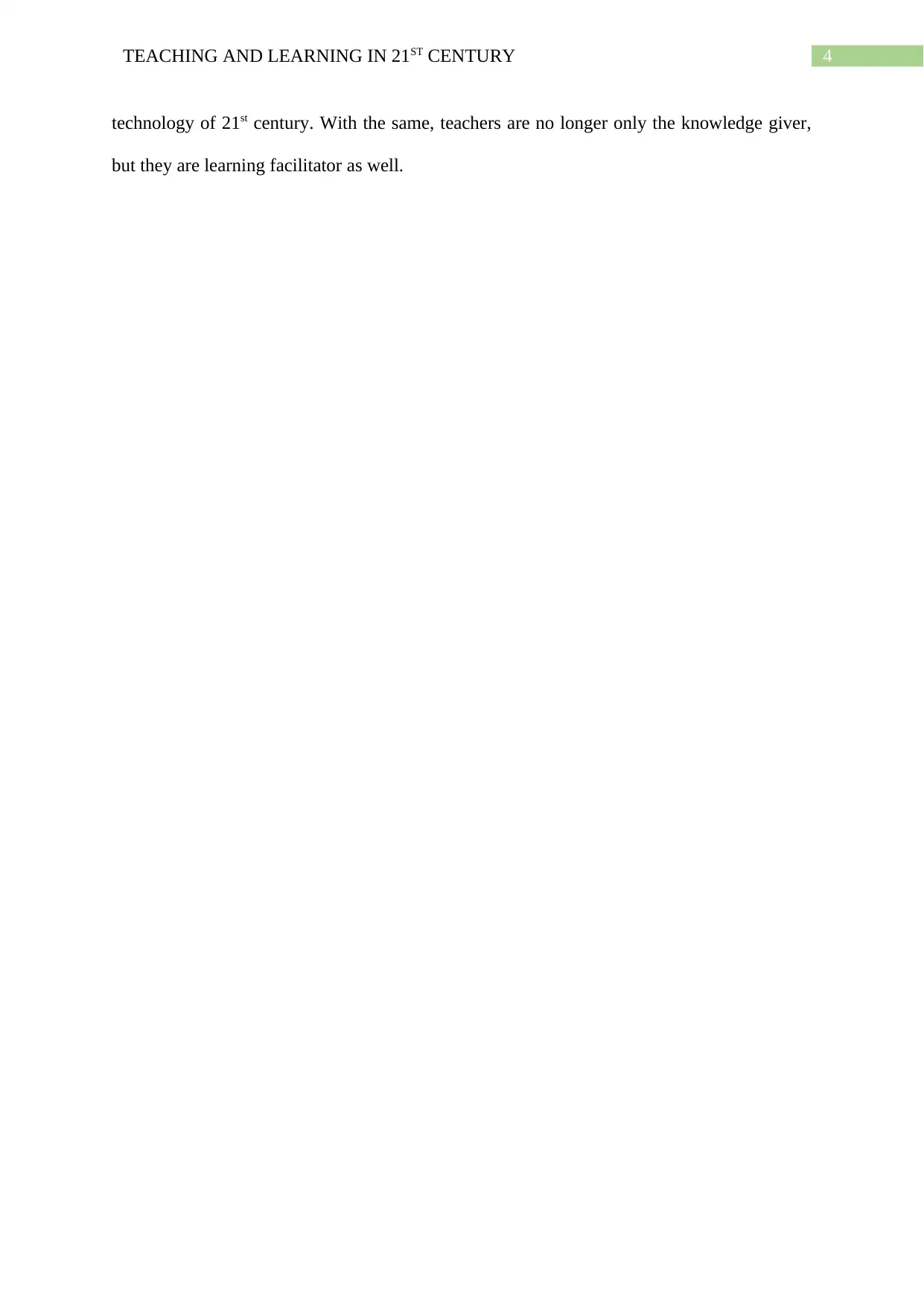
4TEACHING AND LEARNING IN 21ST CENTURY
technology of 21st century. With the same, teachers are no longer only the knowledge giver,
but they are learning facilitator as well.
technology of 21st century. With the same, teachers are no longer only the knowledge giver,
but they are learning facilitator as well.
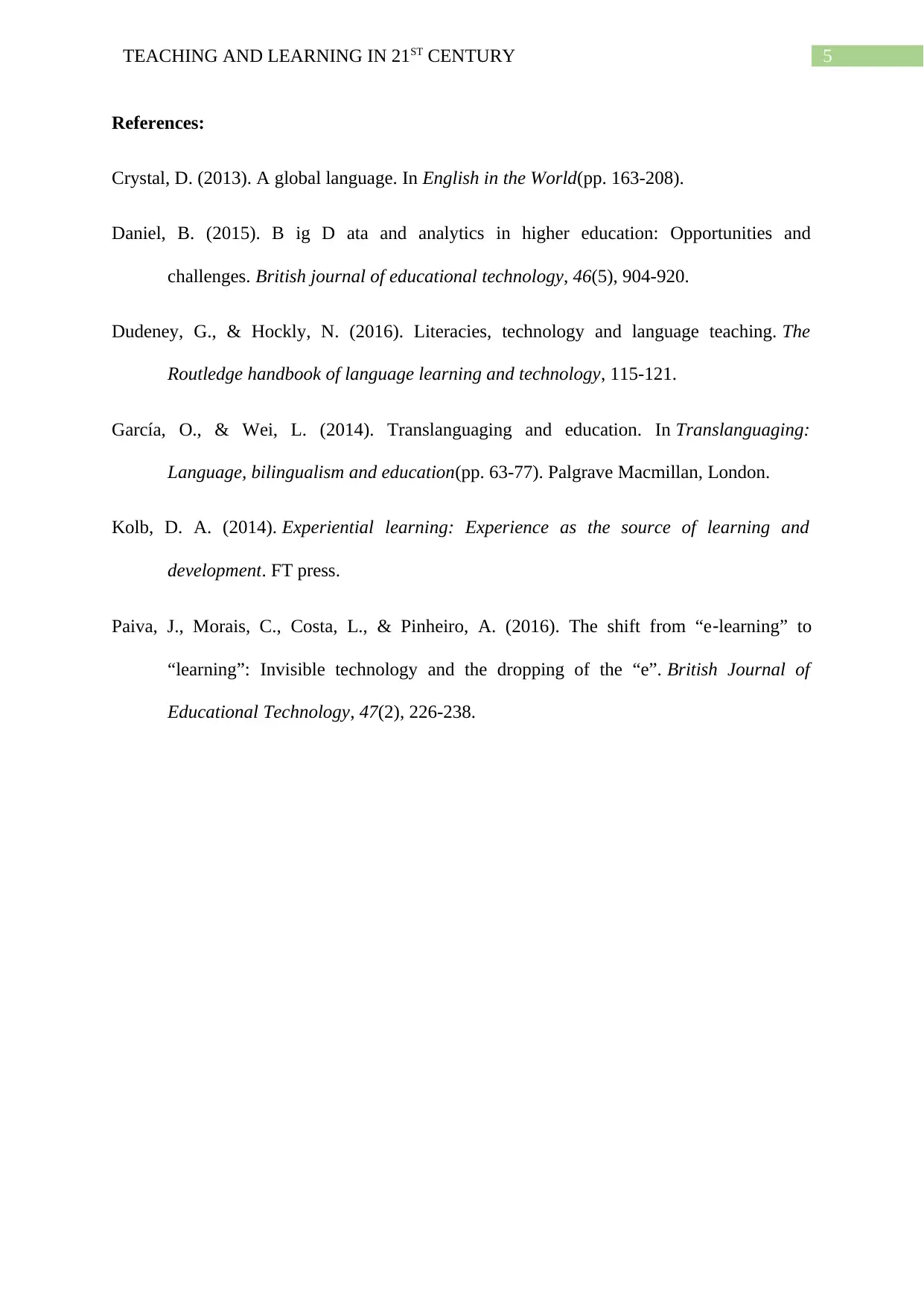
5TEACHING AND LEARNING IN 21ST CENTURY
References:
Crystal, D. (2013). A global language. In English in the World(pp. 163-208).
Daniel, B. (2015). B ig D ata and analytics in higher education: Opportunities and
challenges. British journal of educational technology, 46(5), 904-920.
Dudeney, G., & Hockly, N. (2016). Literacies, technology and language teaching. The
Routledge handbook of language learning and technology, 115-121.
García, O., & Wei, L. (2014). Translanguaging and education. In Translanguaging:
Language, bilingualism and education(pp. 63-77). Palgrave Macmillan, London.
Kolb, D. A. (2014). Experiential learning: Experience as the source of learning and
development. FT press.
Paiva, J., Morais, C., Costa, L., & Pinheiro, A. (2016). The shift from “e‐learning” to
“learning”: Invisible technology and the dropping of the “e”. British Journal of
Educational Technology, 47(2), 226-238.
References:
Crystal, D. (2013). A global language. In English in the World(pp. 163-208).
Daniel, B. (2015). B ig D ata and analytics in higher education: Opportunities and
challenges. British journal of educational technology, 46(5), 904-920.
Dudeney, G., & Hockly, N. (2016). Literacies, technology and language teaching. The
Routledge handbook of language learning and technology, 115-121.
García, O., & Wei, L. (2014). Translanguaging and education. In Translanguaging:
Language, bilingualism and education(pp. 63-77). Palgrave Macmillan, London.
Kolb, D. A. (2014). Experiential learning: Experience as the source of learning and
development. FT press.
Paiva, J., Morais, C., Costa, L., & Pinheiro, A. (2016). The shift from “e‐learning” to
“learning”: Invisible technology and the dropping of the “e”. British Journal of
Educational Technology, 47(2), 226-238.
⊘ This is a preview!⊘
Do you want full access?
Subscribe today to unlock all pages.

Trusted by 1+ million students worldwide
1 out of 6
Related Documents
Your All-in-One AI-Powered Toolkit for Academic Success.
+13062052269
info@desklib.com
Available 24*7 on WhatsApp / Email
![[object Object]](/_next/static/media/star-bottom.7253800d.svg)
Unlock your academic potential
Copyright © 2020–2025 A2Z Services. All Rights Reserved. Developed and managed by ZUCOL.




